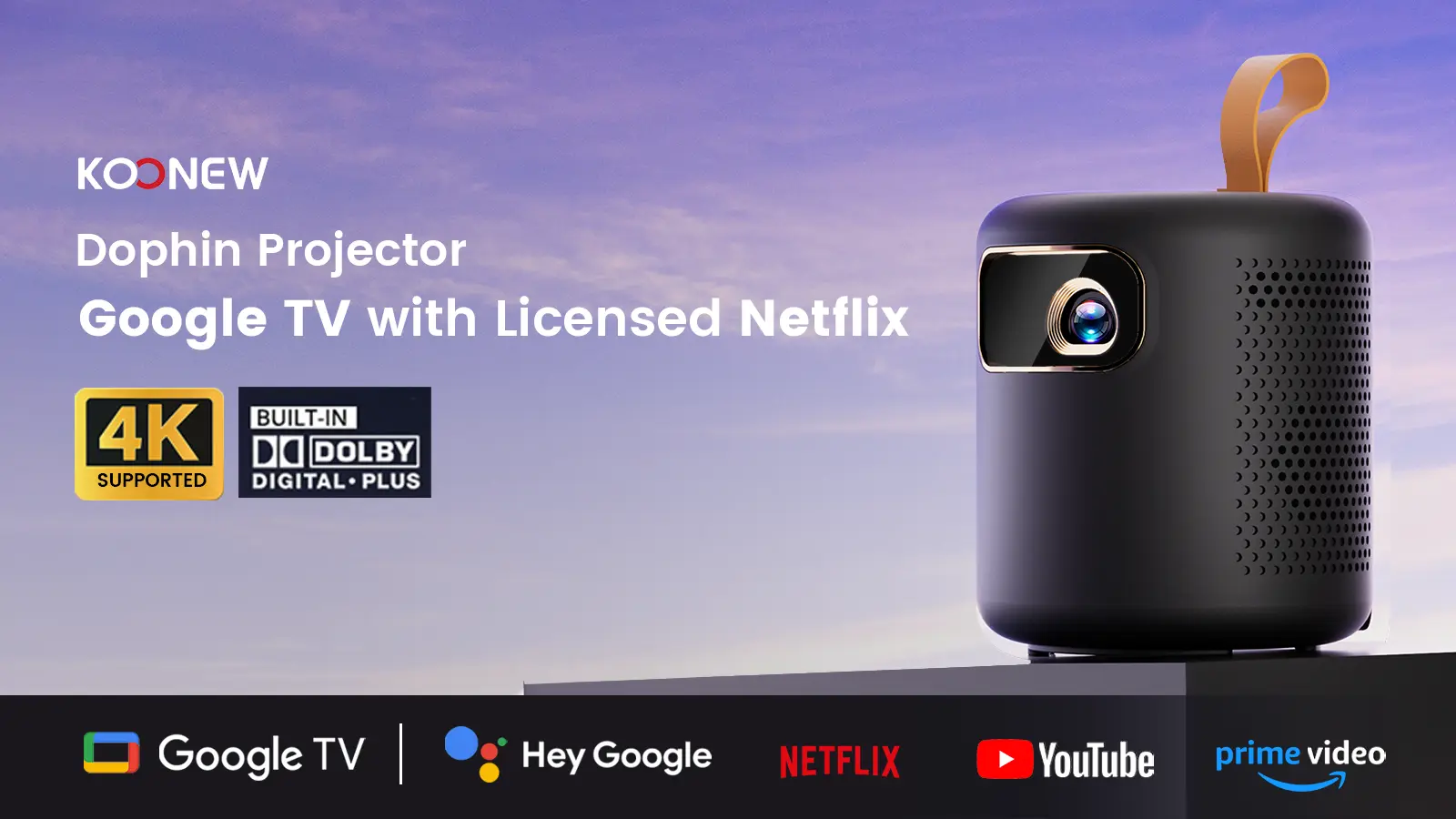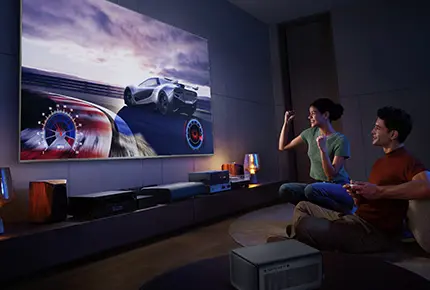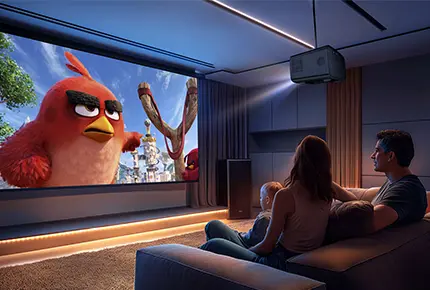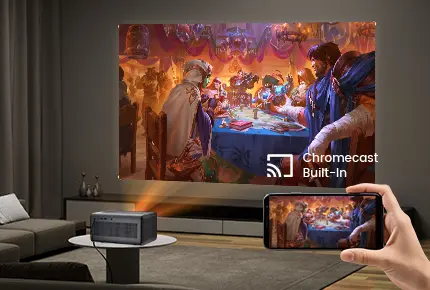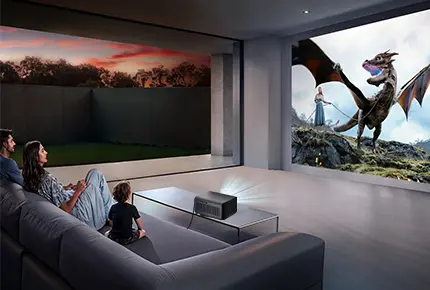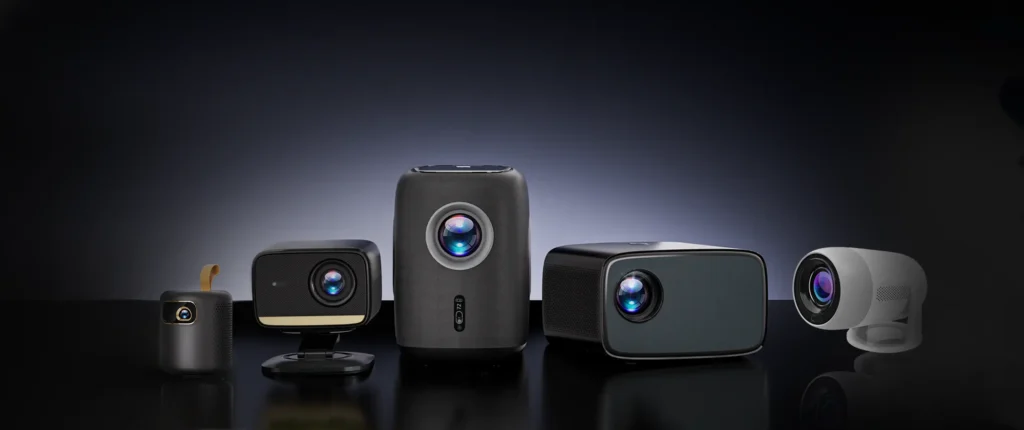
DLP (Digital Light Processing) is a projection technology developed by Texas Instruments, renowned for its high contrast, reliability, and suitability for large-scale applications. Its core component is the DMD (Digital Micromirror Device) chip, which comprises millions of microscopic mirrors that tilt ±10° to reflect light toward or away from the projection lens, creating images pixel by pixel.
How does a DLP projector work?
1. Single-Chip DLP Projectors
A single DMD chip sequentially reflects red, green, and blue light using a rotating color wheel. Due to the persistence of vision in the human eye, these rapidly alternating colors blend into full-color images.
Lower cost, compact design, and high brightness are the advantages of single-chip DLP projectors. However, there are also some limitations, such as the rainbow effect (occasional color separation artifacts during high-contrast scenes), and color accuracy may lag behind three-chip systems.
2. Three-Chip DLP Projectors
Three dedicated DMD chips independently process red, green, and blue light. The reflected light combines via prisms to form images, eliminating the need for a color wheel.
The main advantages of 3-chip DLP projectors are superior color accuracy, contrast, and brightness (up to 50,000 lumens), and no rainbow effect.
The limitations are complex optics and significantly higher cost compared to single-chip models.
Key Features of DLP Technology
Image Quality:
Tight mirror spacing enables pixel-free, seamless images with high resolution and grayscale precision.
Durability:
Sealed optical design prevents dust ingress, extending lifespan (DMD chips withstand >100,000 hours of operation).
Brightness Efficiency:
Reflective DMD design minimizes light loss, supporting ultra-high brightness (up to 75,000 lumens in laser-DLP hybrids).
Brightness Efficiency:
Microsecond-level mirror switching reduces motion blur, ideal for fast-paced content.
Is DLP Projector Better Than LCD? (Technology Comparison of DLP vs. LCD)
First, DLP and LCD are two different display technologies: DLP uses micromirrors to reflect light, while LCD uses liquid crystals to transmit light.
Secondly, DLP provides more natural color transitions and higher contrast, while LCD delivers more vibrant colors and better color reproduction but has lower contrast. DLP also has faster response speed (microseconds) compared to LCD (milliseconds). In terms of brightness efficiency, DLP performs better than LCD.
In other aspects, DLP projectors are usually more compact and lightweight than LCD projectors. With a fully sealed optical engine, DLP models offer better dust protection and lower maintenance costs.
DLP technology excels in high-contrast, fast-response, portable, and high-reliability scenarios. Single-chip systems balance cost and performance, while three-chip variants dominate premium large-venue markets.
High color reproduction and cost-effectiveness are highlights of LCD. For consumers, factors like ambient lighting, content type (e.g., gaming vs. cinema), and budget should guide the choice between DLP and alternatives like LCD.
Practical Application Considerations of DLP Projectors
Home/Office Use:
Single-chip DLP is sufficient for brightness <5,000 lumens; prioritize laser/LED light sources for longevity.
Professional Use:
Three-chip DLP is optimal for brightness >20,000 lumens and color-critical applications (e.g., concerts, museums).
Emerging Trends:
Triple-laser light sources paired with DLP enhance color gamut and brightness uniformity, emerging as a premium solution.
Koonew DLP Projectors Recommendation
Koonew Mini DLP Projector A-2341G:
A mini portable smart DLP projector with native 1080P resolution and smart Google TV operating system. Built-in batteries break the limits of power supply. It’s suitable for indoor and outdoor entertainment, mobile work, and more.
Koonew Mini DLP Projector A-2341G
Koonew Business DLP Laser Projector WX50X:
This laser projector offers 4000 ANSI lumens of brightness, balanced high color accuracy and brightness, wide color gamut and uniformity, and a 20,000-hour long lifespan. Its 720° rotation provides flexible installation. It is more suitable for business and educational scenarios.

